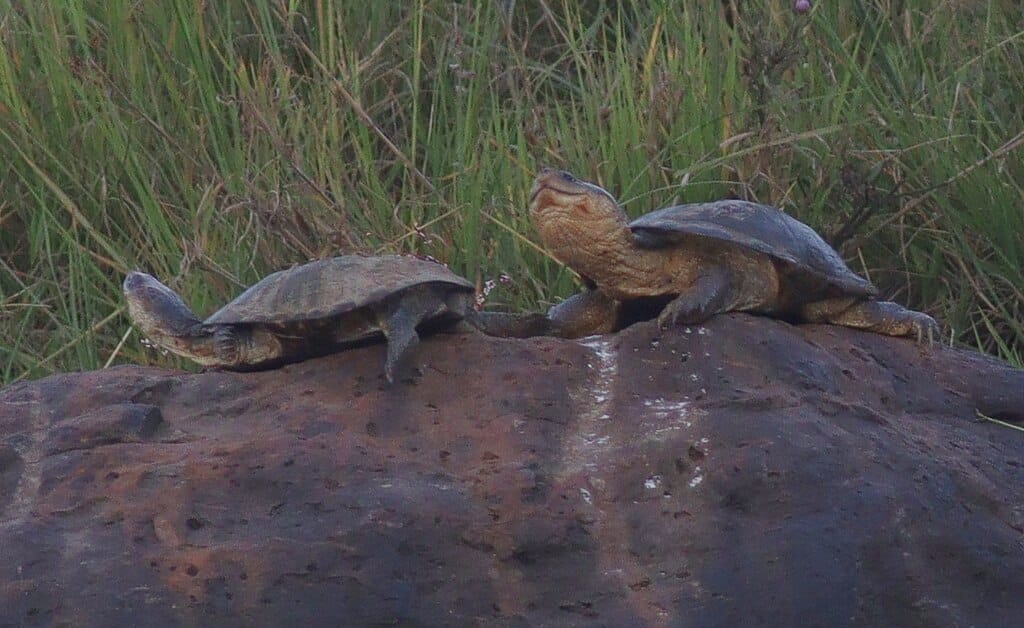Pelomedusa neumanni (Neumann’s marsh terrapin)
Home > Turtle Database > Pelomedusa neumanni (Neumann’s marsh terrapin)

Pelomedusa neumanni, or Neumann’s marsh terrapin, is a freshwater turtle native to East Africa. Known for its adaptability, this species thrives in various aquatic environments, often surviving in harsh conditions where other turtles might struggle.
Native To These Regions
Ethiopia, Kenya, Somalia, South Sudan, Tanzania, UgandaNative Turtle Species Map – Find Turtles by Region
Scientific Classification
Kingdom: Animalia
Phylum: Chordata
Class: Reptilia
Order: Testudines
Family: Pelomedusidae
Genus: Pelomedusa
Species: Pelomedusa neumanni
Common Names
Neumann’s marsh terrapin
East African marsh terrapin
This Hilarious Turtle Book Might Know Your Pet Better Than You Do
Let’s be real—most turtle care guides feel like reading a textbook written by a sleep-deprived zookeeper.
This one’s not that.
Told from the snarky point of view of a grumpy, judgmental turtle, 21 Turtle Truths You’ll Never Read in a Care Guide is packed with sarcasm, sass, and surprisingly useful insights.
And hey—you don’t have to commit to the whole thing just yet.
Grab 2 free truths from the ebook and get a taste of what your turtle really thinks about your setup, your food choices, and that weird plastic palm tree.
It’s funny, it’s honest, and if you’ve ever owned a turtle who glares at you like you’re the problem—you’ll feel seen.
Identification
Description
This turtle has a domed, oval-shaped carapace that ranges from brown to olive, often darker with age. The plastron is pale with dark seams along the scutes. Its head is broad with large eyes and a blunt snout.
Sexual Dimorphism
Females are typically larger with shorter tails, while males have longer, thicker tails and a slightly concave plastron to aid in mating.
Check more turtles from the Pelomedusa genus
Native Origin and Distribution
Geographical Range
Pelomedusa neumanni is found in East Africa, particularly in Ethiopia, Kenya, Tanzania, and Uganda.
Preferred Habitat
This terrapin prefers slow-moving or stagnant freshwater bodies such as marshes, ponds, and swamps. It often inhabits temporary water sources and can tolerate seasonal drying by burrowing into mud.
Behavior
Feeding Habits
It is an opportunistic feeder, consuming insects, aquatic invertebrates, small fish, and plant matter. It adapts its diet based on availability.
Predators
Predators include large birds, crocodiles, and humans, who may capture them for food or trade.
Reproduction
Breeding Season
Breeding typically occurs at the start of the rainy season when water bodies are abundant.
Reproductive Method
Females lay clutches of 10 to 30 eggs in sandy or muddy banks near water. The eggs incubate for about 2-3 months before hatching.
Conservation
Extinction Status
Not Evaluated
Threats
Habitat loss from agriculture and urbanization, pollution, and capture for the pet trade are major threats.
Conservation Measures
Protected areas and wetland conservation projects help safeguard their habitats. Local regulations in some countries restrict their capture and trade.
Economic Importance
In some regions, these turtles are collected for the local pet trade and occasionally used in traditional medicine. They also play a role in controlling insect populations in wetlands.
Interesting Facts
Pelomedusa neumanni can survive long dry periods by aestivating underground, sealing itself in a mud cocoon. Unlike many turtles, it cannot retract its head straight back but tucks it sideways beneath the shell edge.

About Author
Muntaseer Rahman started keeping pet turtles back in 2013. He also owns the largest Turtle & Tortoise Facebook community in Bangladesh. These days he is mostly active on Facebook.














